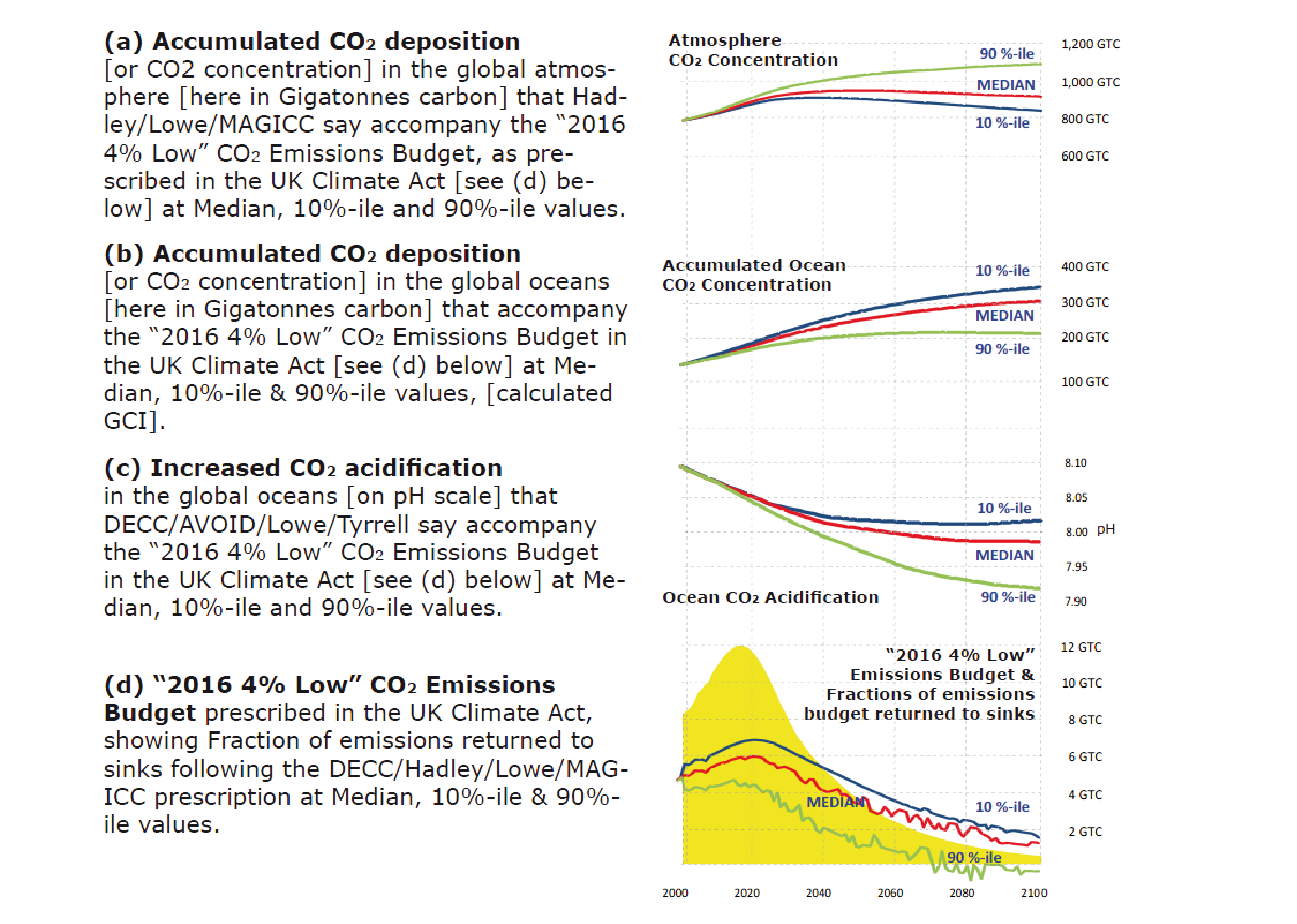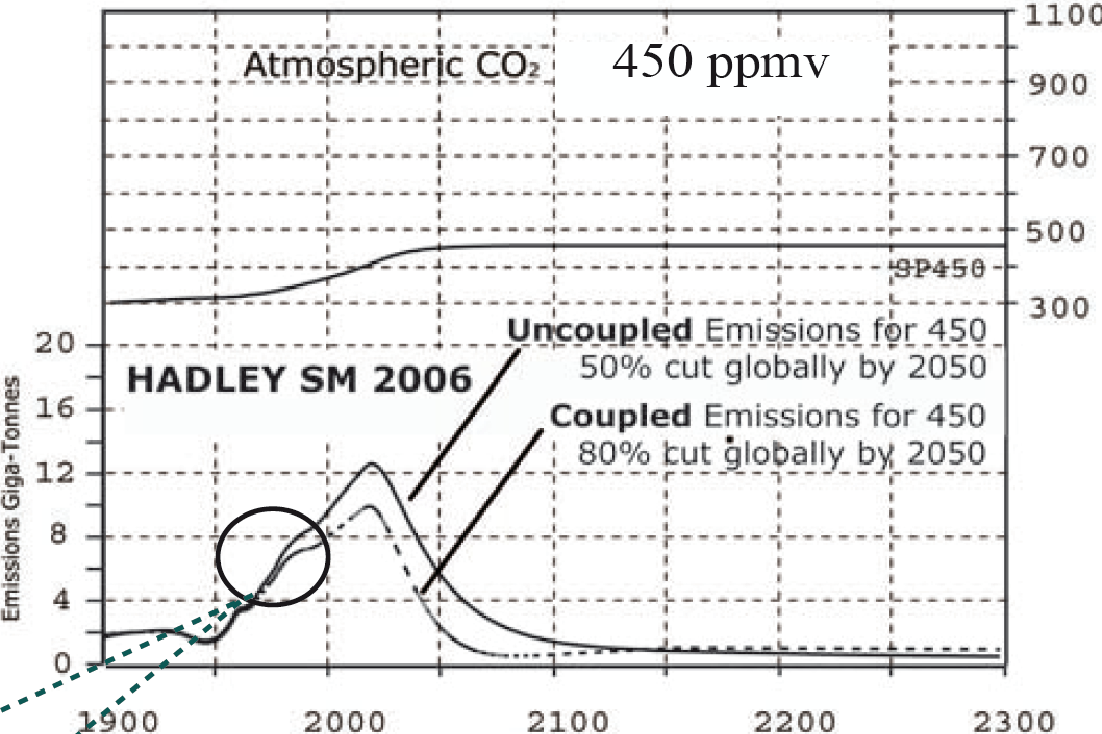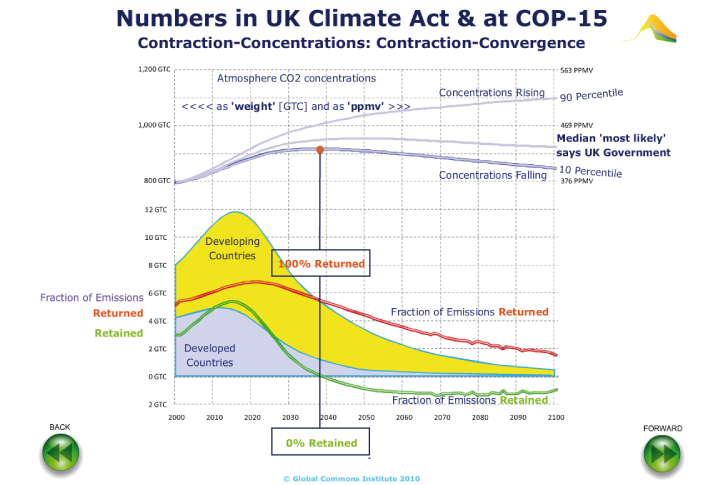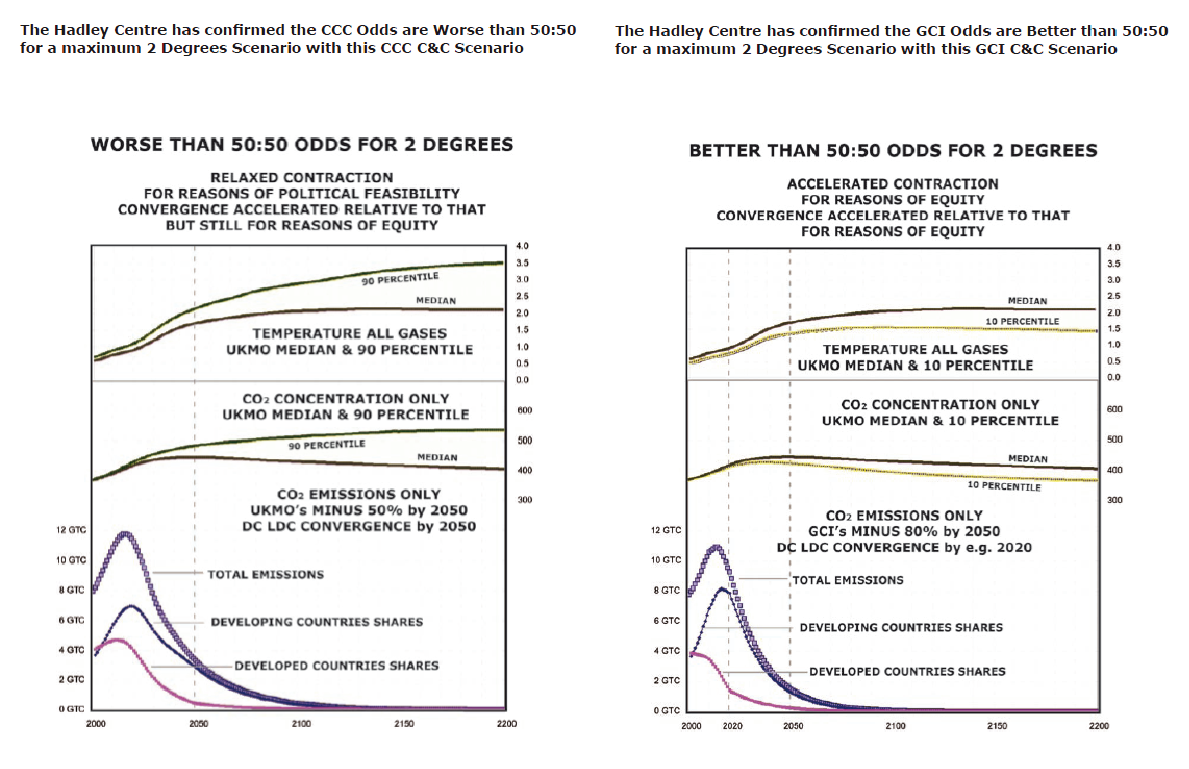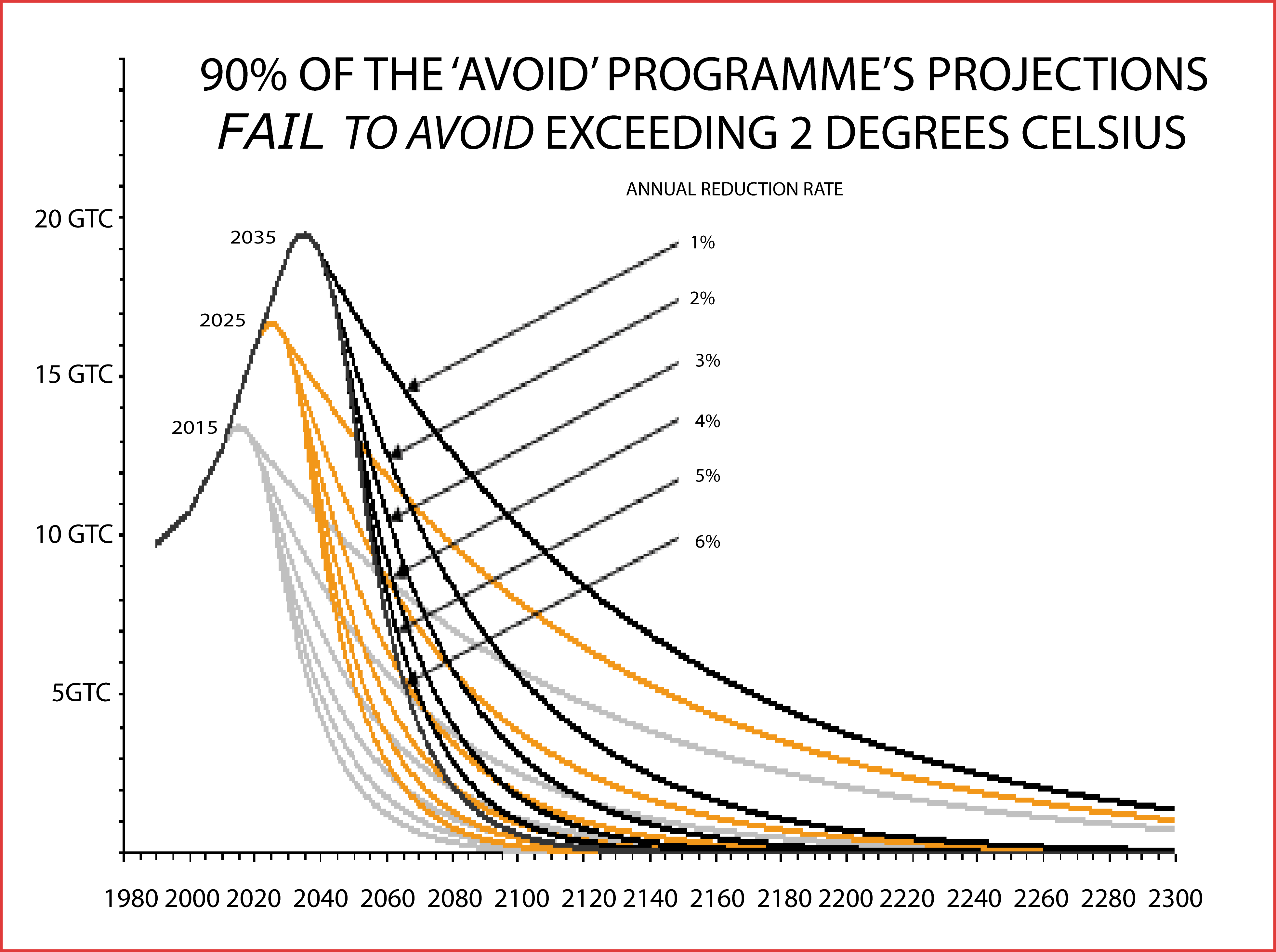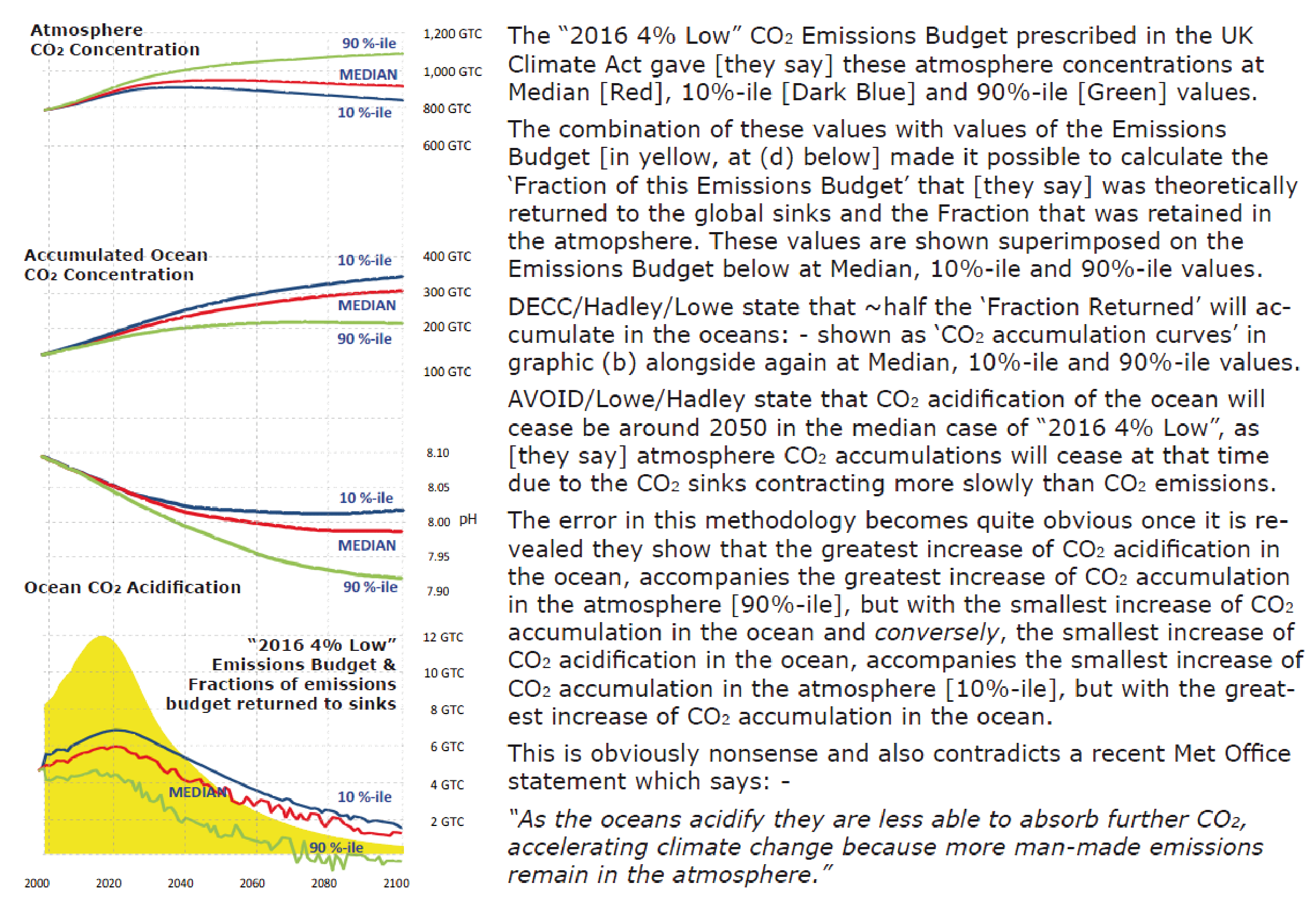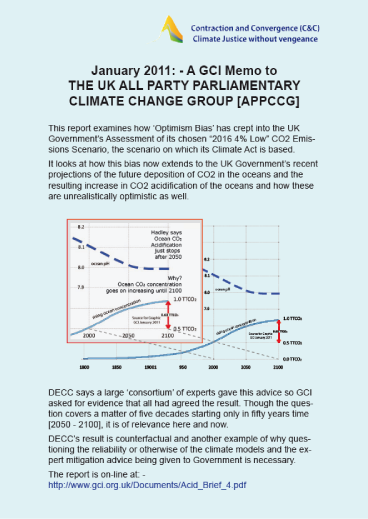The saga over numbers for 'ocean-acidification in the UK Climate Act' goes on
"Ocean acidification is a direct result of the absorption of carbon dioxide by the Ocean. This threatens all marine animals and plants that secrete calcium carbonate as part of their structure. We believe that this has already caused a reduction in the size and growth rates of some marine animals."
International Programme on the State of the Oceans
There is conspicuous error in the UK Government's projections of ocean acidification in the UK Climate Act and its global CO2 emissions budget, "2016 4% Low". The UK Government appears unwilling to acknowledge, let-alone discuss this.
Southampton University Oceanography Department, who did the acidification projections, are still unwilling to believe that the UK Government's figures actually have created this error in what they have published with “2016 4% Low”.
The error is very easy to demonstrate by looking at their published spreadsheets* - in summary they say: -
- The UK Government's CO2-emissions-budget "2016 4% Low", for the period 2000-2100,
weighs 480 Gigatonnes carbon [GTC].- So for 2000, 2050 and 2100 their emissions and atmospheric concentrations as weights of carbon, are variously: -
CO2 Emissions in the "2016 4% Low" Carbon Emissions Budget in the UK Climate Act Atmosphere CO2 Concentrations shown by HMG with the "2016 4% Low" 10%-ile median 90%-ile Consequently, the CO2 that is taken by sinks' in HMG's '10%-ile', the 'median' and the '90%-ile' cases is revealed.
What is shown in the next table is what inexorably follows, namely that either side of the 'median' case: -
- when there is more CO2 in the atmosphere, as with the 90%-ile case, then there is less CO2 in the sinks, or
- when there is less CO2 in the atmosphere, as with the 10%-ile case, then there is more CO2 in the sinks.
Note when each of these amounts of CO2 is added to 'the extra CO2 that remains in the atmosphere',
the total in each case is the 480 GTC, as was prescribed in the "2016 4% Low" CO2 budget spreadsheets
Atmosphere CO2 Concentrations showing net effect of 'sinks' with the "2016 4% Low" 10%-ile
by 2100 there is an extramedian
by 2100 there is an extra90%-ile
by 2100 there is an extraDECC says the CO2 taken away by the sinks is sub-divided ~ 50:50 between the ocean and land sinks.
So it's not rocket-science now to show the UK Government's AVOID programme claim, that: -
- there is greater ocean CO2-acidification [see below] when there is less CO2 in the ocean [167.8 * 0.5 GTC] or
- there is lesser ocean CO2-acidification [see below] when there is more CO2 in the ocean [418.7 * 0.5 GTC],
as shown here in the original memo and that this is the conspicuous error as projecting this obviously defies common sense.
So we can go back and ask, is there more CO2 being released from other undeclared sources perhaps?
This is part of what GCI argued to the Environmental Audit Committee enquiry in 2009 as it appears a virtual certainty that there will be other significant sources of CO2 emissions in the period 2000 - 2100, due to the effect of constantly rising temperature melting the tundra and the permafrost, triggering dessication and combustion of forests, oceanic sink-regression and more CO2 out-gassing for example. This is the only conceivable way to 'correct the error' the Government is projecting.
If this is the case, then DECC/Hadley/AVOID need to specify what, as in their spreadsheets accompanying the Climate Act: -
- these sources of ‘other releases’ are [e.g. permafrost, tundra melt, ocean-outgassing etc]
- the path-integrals for these releases are
- i.e. showing in what amounts these releases are occurring
- and at what rates these releases are occurring.
The CO2 emissions from these sources would be coming from feedbacks that will become the coup de grace for tipping us into runaway rates of climate change with oceans turning to an acid bath, and there is evidence suggesting that these feedbacks may have begun.
However, with the emissions budget "2016 4% Low", as in the UK Climate Act, none of these feedbacks are shown or even intimated at in the Government's published figures.* However, evidence for Dr John Mitchell [of the UK Hadley Centre] to the Environmental Audit Committee in the UK Parliament in March 2009 insisted that they were: -
Q130 Joan Walley: The concern that I have is that, in evidence that we have had from the Global Commons Institute from Aubrey Meyer, he has pointed out that the IPCC has specifically said the omission feedbacks from models was an issue and that the real question is whether or not you have coupled or uncoupled feedbacks. Is that something which you have taken into account?
Professor Mitchell: The models will take into account all the feedbacks we are aware of that we think are important, then we can quantify that we understand, and to that extent the Climate Change Committee has obviously done that. Science being science, we uncover new feedbacks and there is a delay in being able to incorporate those in the complex models. One can use simple models to get, if you like, a fast-track estimate of what the effect would be, but one would have to refer to the more complex models to make sure that when you add that additional feedback you are actually taking into account all the processes that are important.
Note: - at this point in 2009 no ocean-CO2-acidification estimates had even been suggested, let-alone provided by Government at all.
The evidence got worse. Dr Jason Lowe of the Met Office acknowledged the higher atmosphere-CO2-concentration outcomes when the feedback-effects of 'carbon coupling' were added, and then just dismissed the issue by falsely claiming these feedback effects had been 'included' in "2016 4% Low"
Q131 Joan Walley: Two things on that. The first thing is that Aubrey Meyer said that the models used by the Committee on Climate Change were uncoupled. Therefore, his recommendation was that, because they were uncoupled, they were not suitable. Would you agree with that?
Dr Lowe: I am going to take that one. I had a look at the submission from the Global Commons Institute last night and the figure I think you refer to comes from IPCC in chapter 10 and, in this context, “uncoupled” refers to whether temperature feeds back onto the carbon cycle, so where the temperature and rainfall can affect how trees take up carbon, and it has a very particular meaning. For the curve in question, basically you run the model without this effect of climate feedback on to trees and the biosphere and you get one number, you run it again with this effect, the coupled version, you get a different number and, if you have got the same emissions going in, the coupled version leads to typically a higher concentration because you are increasing the emissions that come back from the biosphere.
[Editor's note: - equally this means that holding to the same concentrations level, a lower emissions output is required, which is what C4MIP and IPCC AR4 showed and what GCI was pointing out to the EAC and what, in 'policy-terms' is much more responsible way to address the issue.
The runs that the Climate Change Committee used to include those feedbacks, so in that definition they were described as coupled. The precise values we use to work out the magnitude of the coupling comes from elsewhere in IPCC and from a study referred to as a C4MIP study, which to date is the most comprehensive analysis of that particular type of feedback onto the carbon cycle.
Here is the image of the runs from "Hadley SM 2006" for coupled and uncoupled for 450 ppmv in the atmosphere as published in IPCC AR4: -
- 'Uncoupled' is effectively "2016 4% Low", peaking in 2016 at 12 GTC and descending to ~zero by 2100, in other words the equivalent of "2016 4% Low" with a CO2 emissions-budget-total [2000-2100] of around 480 GTC.
- 'Coupled' is peaking in 2016 at 11 GTC and descending to ~zero by 2050, in other words much 'faster' than the equivalent of "2016 4% Low" with a much reduced CO2 emissions-budget-total [2000-2100] of around only 380 GTC.
But at the time of Jason Lowe's evidence in 2009, it was clear in the already published 'Statute' [the UK Climate Act] that Government, advised by the same Hadley Centre/Met Office and the 'Climate Change Committee', had prescribed this same "2016 4% Low" 'median case' allegedly with feedbacks all included . . . with emissions in a fixed budget at the uncoupled rate [480 GTC 2000 - 2100] but with concentrations ppmv not rising but falling back from 2050 as shown again in the audit-animation below.
In other words in the UK Climate Act with "2016 4% Low" - and what the UK took to UN at COP-15 in 2009 as their prescription for the 'global climate deal' - suddenly in total the feedbacks are not positive, they are negative and so the sinks are taking more CO2 out of the atmosphere after 2050 than we are emitting to it between 2050 and 2100!!
The trouble is, if this were true, at least half of it is going into and adding up in the oceans. But DECC/AVOID/Hadley/-Southampton University don't worry about any 'increase of CO2 there beyond 2050' because - and they all assert this - that ocean CO2 acidification won't be increasing in the ocean because pH in the ocean responds only CO2 concentration in the atmosphere and not CO2 concentration in the oceans; [if only they'd done some book-keeping arithmetic].
However, the remarkable thing is this. This extraordinary 'good news' about the feedback effect coming into play being 'negative' went wholly without fanfare or even comment. No mention of it was made in words of the Report by the Hadley Centre or the Climate Change Committee or DECC or the Minister - not in a press release, a chapter title, a sub-heading, or even a footnote. They just slipped it in completely out of sight in the depths of spreadsheets that most people wouldn't even be aware of let-alone look at in the technical annexes to the report "Building a Low Carbon Economy" shown in the animation of their work modelled out here: -
Now, this same Dr Jason Lowe of the Hadley Centre manages the Government's AVOID [i.e. Avoiding 2 Degrees] programme - what DECC calls a large consortium of 'experts'. This, for the first time in only 2010, published the ocean-CO2-acidification estimates, containing however, the conspicuous error identified above resulting from model runs which overall claimed they had: -
- included all the feedback effects they deemed relevant
- seen CO2 concentrations falling after 2050 because of this negative feedback
- identified that ocean-CO2-acidification would therefore stop increasing after 2050
- prescribed equal per capita entitlements globally by 2050, [by when 80% of the "2016 4% Low" budget was used up]
- given - unfortunately - only 44% odds for avoiding more than 2 degrees with "2016 4% Low".
[Minus the acidification part, when the UK and friends tried to prescribe this scenario at UNFCCC COP-15 they were rebuffed].
Anyway, under pressure during the 2009 EAC enquiry into Carbon Budgets,
- Hadley Centre agreed faster emissions contraction gives better odds for avoiding more than 2 degrees C rise
- Adair Turner conceded, “if contraction must be accelerated for reasons of urgency, convergence must be accelerated relative to that for reasons of equity.”
Yet now in June 2011, the veteran UK Climate Negotiator at the UNFCCC David Warrilow, armed with recent results from this same AVOID consortium is as part of the UK Government's Climate Delegation to the UNFCCCnegotiations in Bonn now [10 06 2011] unbelievably talking about and modelling global emissions peaking perhaps in 2025 or even 2035, in other words with carbon-emissions-budget-integrals that are up to more than ten times the quantum of carbon and what they claimed was sufficient with 56% odds to actually trigger more than two degrees with "2016 4% Low".
Never mind all the earlier contradictions and error, for any Government to be 'modelling' the CO2 concentrations and ocean-acidification implications of these scenarios is yet suggesting somehow we would still 'have control' and that UNFCCC-compliance was still possible with them. This is drastically irresponsible because it is not. It wholly ignores that these slower contraction rates invite not just more feedbacks, but effectively going over an 'event-horizon' the other side of which lie dangerous and uncontrollable rates of climate change which will make UNFCCC-compliance completely impossible.
Acting in this manner also however, invites accusations of becoming part of what is now, after twenty years of deepening failure at the UNFCCC, virtual complicity in planting misleading information as part of wider efforts to avoid any blame in the UK for engendering a future climate catastrophe.
Just to put this in the context of UNFCCC-negotiations right now [10 06 2011], the Executive Secretary Christiana Figueres has just said that 2 degrees is too high and issued a call for 'tougher targets' aimed at not exceeding 1.5 degrees!
~~~~~~~~~~~~~~~~~~~~~~~~~~~~~~~~~~~~
Presentation/animation: An assessment of 'Contraction & Concentrations' and 'Contraction & Convergence' and the C&C targets and modelling behind various rates of 'sink-efficiency' in the UK Government's 'Climate Act' [2008]. [Also 'download and save' as a self-executing PC file here & Mac file here].
An assessment of 'Contraction & Concentrations' and 'Contraction & Convergence' and the C&C targets and modelling behind various rates of 'sink-efficiency' in the UK Government's 'Climate Act' [2008].
This presentation/animation audits the "2016 4% Low" CO2-contraction:atmospheric-CO2-concentrations:convergence budget that is the Government's prescribed basis of the UK Climate-Act. The Government's prescription results from runs of the MAGICC climate-model that the UK Hadley Centre was requested to conduct with an overall view to avoiding a global temperature rise of more than two degrees.
Keeping the CO2 emissions budget ['2016 4% Low'] constant and selecting the 'median' case for the resultant CO2 concentrations in the atmosphere, Government published the view that this scenario gave 44% odds for now exceeding an overall temperature rise of 2 degrees by 2100.
DECC and AVOID's METHODOLOGY IS FLAWED
This document with graphics is downloadable here: -These graphs and the whole document are downloadable here
Subsequently DECC, using analysis from members of the consortium in the AVOID programme, projected calculations of future increases in 'ocean acidification', or pH decreases, onto this fixed prescription Of CO2 emissions:concentrations.
In the total ensemble of results from their "2016 4% Low" 'scenario', 2050 emerges as a year of great significance as the Government's prescription displays the following four features: -
- atmospheric CO2 concentrations peak in 2050 and then start declining,
consequently . . .- sinks are absorbing more than the emissions equivalent from 2050 onwards and . . .
- ocean acidification stops increasing from 2050 onwards and within contraction
- convergence to globally equal emissions entitlements per capita is completed by 2050.
GCI audited this ensemble and serious contradictions emerge. What DECC/AVOID have done was to: -
- prescribe a fixed CO2 emissions budget [2016 4% Low]
- project an array of atmosphere CO2 concentrations paths [10%-ile;median;90%-ile] that result from this and then separately
- project arrays of ocean CO2 acidification paths that result from these atmosphere concentration pathways.
What they didn't do was to look at ocean CO2-concentration pathways that resulted from the above which reveal the contradiction discussed here.
Using the detailed projections of emissions and concentrations for 2016 4% Low given in the Committee of Climate change report ‘Building a Low Carbon Economy’ [2008], Chapter 1 spreadsheet, Model Emissions and Climate Data, GCI produced a time-series as follows: -
- quantify the carbon-weights of the CO2 concentration pathways and then, against the CO2 budget . . .
- quantify the carbon-weights of the 'fractions-of-CO2-emissions-returned-to-the-sinks' [FERTS] & . . .
- quantify the 'fractions-of-CO2 emissions-retained-in-the-atmosphere' [FERTA] that result and . . .
- quantify the 'accumulated-fractions-of-emissions-returned-to-the-sinks' [AFERTS] . . .
- assign 50% of AFERTS to the ocean-sinks [AFERTOS] . . .
- compare the various rates of AFERTOS with the rates of ocean-acidification.
What emerges from this audit is the DECC/Hadley/AVOID modelling of future CO2 emissions:ocean-atmosphere-concentrations:ocean-acidification has a major contradiction. They claim: -
- ocean CO2 acidification is a function only of increasing atmospheric CO2 concentration and
- increasing ocean acidification is not a function of increasing oceanic CO2 concentration but that
- increasing oceanic CO2 concentration is a function of increasing atmospheric CO2 concentration
- and further that oceanic CO2 acidification increases while oceanic CO2 concentration does not or
- oceanic CO2 concentration increases while oceanic CO2 acidification does not.
In other words the AVOID/DECC results claim what is impossible in the real world: that ocean CO2 acidification can just stop while ocean CO2 concentration continues to increase and/or that ocean CO2 concentration can just stop while ocean CO2 acidification continues to increase.
These graphs and the whole document are downloadable here
This impossibility shows that the key part of this modelling was omitted, namely the effect on the biological aspect of the ocean sink of increased levels of CO2 acidification. This omission results from 'fixing' and prescribing the CO2 budget and the concentrations paths that are portrayed as 'high/middle/low' and telling oceanographers to predict ocean-acidification-levels off the atmosphere CO2 concentration paths only.
This is about an audit of “2016 4% Low” revealing the use by DECC/AVOID of a bureaucratic and demonstrably flawed modelling procedure to achieve projections of CO2 concentration in the atmosphere and the oceans.
Dr Toby Tyrrell of Southampton Oceanography Department, who was tasked with projecting the rates of ocean acidification under “2016 4% Low” said: -
- “the time evolution of atmospheric CO2 was prescribed. We imposed it on the model and then calculated the resulting impact on pH” and
- “these model runs are not suitable for calculating the ocean CO2 sink over time, and therefore neither are they suitable for calculating the fraction of emissions that is retained in the atmosphere.”
It goes without saying that he’s welcome to say that, but that is exactly what the DECC/AVOID model runs did as shown in the spreadsheets accompanying the publication of the UK Climate-Act; they give year-on-year values for CO2 emissions and CO2 concentrations. Southampton’s imposing the CO2 concentrations only to calculate the resulting impact on ocean CO2 acidification is flawed as it cuts out a - if not the - key bit of the modelling challenge [quantifying the impact on ocean-sink biology] and contradicts the Met Office’s own statement on its web-site which says: - “As the oceans acidify they are less able to absorb further CO2, accelerating climate change because more man-made emissions remain in the atmosphere.”
The more reliable way to model this, and the more responsible way ahead is Recommended Concentration Pathways [RCPs] i.e. to 'fix' the atmosphere CO2 concentration level and then vary the size of the “CO2 “emissions-budget - high/middle/low” around that and then predict the ocean-acidification-level off the concentration paths with the 'high/middle/low' error bars being a function of the sizes of the budget and the 'high/middle/low' AFERTOS pathways arising from that.
This has the further virtue of avoiding the contradictions stated above.
The IPCC 5th Assessment calls for RCPs. Here’s another reason to work to RCPs.
~~~~~~~~~~~~~~~~~~~~~~~~~~~~~~~~~~~
The core reading of all this is that: -
- increased acidification of the ocean will continue to occur with "2016 4% Low" median case concentrations;
- this will negatively affect the ocean uptake of CO2 because more ocean acid equals less sink-function in the ocean biology;
- the only way to avoid this is to put less CO2 in the atmosphere in the first place. Hadley had already agreed with GCI on this point during the 2009 EAC Enquiry into carbon-budgets in the UK Climate Act
GCI - with difficulty - has actually been arguing this since 1996.
In simple terms, “2016 4% Low” is too little too late to avoid 2 degrees and dangerous rates of atmosphere CO2 concentration and ocean CO2 concentration and acidification. Bluntly we cannot continue to dig all this carbon out of the ground, burn it the atmosphere and just hope the oceans will operate like a flush toilet and take 50-100% of it 'away' so that everything else in the carbon-cycle stays in balance.
The object lesson is simple. Unless we do C&C much faster than 2016 4% Low it is too slow an emissions-contraction-event to avoid rising ocean and atmosphere concentrations and ocean acidification and temperature going above 2 degrees so there is no prospect of returning to below current values within Centuries.
The Report below gives some more background detail.
A short REPORT for the UK ALL PARTY PARLIAMENTARY CLIMATE CHANGE GROUP [APPCCG]. It examines how
‘Optimism Bias’ has crept into the UK Government’s Assessment of its chosen “2016 4% Low” Emissions Scenario, the scenario on which its Climate Act is based. It looks at how this bias now extends to the Government’s recent projections of the future deposition of CO2 in the oceans and the resulting increase in CO2 acidification of the oceans, and why they are unrealistically optimistic as well.
.
UNFCCC C&C Submission - Support for Submission - CBAT - Responses to CBAT

